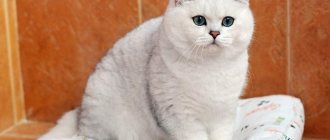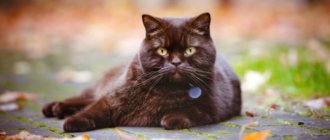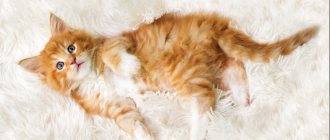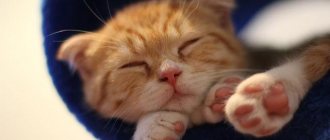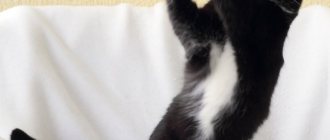Proper feeding and care of a Scottish Fold kitten is the key to the proper growth and development of a purebred pet. Scottish cats, like their relatives of the British breed, are unpretentious in maintenance and care. But the diet must be balanced, because the Scots are prone to a congenital disease in which degenerative processes are observed in the osteochondral system.
Before the kitten appears in the house
Scottish fold kittens are ready to leave their mother cat at about 2-3 months . Before such a kitten appears at your home, you need to prepare for this joyful event.
To do this, you need to purchase: dishes from which your pet will eat and drink, the material should be porcelain or stainless steel, it is possible to use food-grade plastic, as well as a tray with filler and a house, toys can be purchased later. It would be a good idea to learn about the diet from the breeder; this will allow the kitten to more easily adapt to your home.
This is interesting! To visit the veterinarian and travel to the country, you also need to purchase a spacious carrier. You will also need to buy a claw sharpener, however, you can make it yourself. To do this, you can take a simple board or log and wrap it with rope, securing it in a circle.
Return to content
Do domestic cats need to be washed?
After the kittens are born, the mother cat takes care of their washing. The kids learn from her and later cope with hygiene on their own.
Even kittens left without a mother know at the level of unconditioned reflexes that they need to lick themselves. However, each organism is individual, and there are exceptions.
Also, cats are unable to cope with some types of pollution or it takes them a long time.
Situations in which you need to wash your cat:
- The appearance of an unpleasant odor from the skin and fur.
- Presence of obvious contamination.
- Discharge from illness: blood, pus, leakage of urine or feces.
- Before participating in exhibitions.
- When prescribing medicated shampoos by a doctor.
When not to wash your cat:
- During severe acute illnesses.
- At high or low temperatures.
- 2-3 days before and after treatment against ectoparasites (fleas, ticks).
- Before visiting a veterinary dermatologist.
- When bathing is accompanied by severe stress.
Kitten care
Caring for Scottish Fold kittens is easy. The coat does not require special care; it is enough to comb it once a week, and it is enough to wash the eyes once every 5-7 days. The only thing worth paying attention to is ear care. This issue should be treated very carefully. It is the ears that are the calling card of this cat breed, but at the same time they are also a weak point.
Eye examination and cleaning
If your eyes are healthy, then there is no special need for rinsing, you just need to keep them clean. But if the eyes are inflamed, they should be washed 2-3 times a day; this can be done with plain water, a weak chamomile solution or a medicated solution. To do this, you should use a cotton swab or soft cloth. If the inflammation lasts more than a week, then you need to consult a specialist.
Ear cleaning
This procedure needs to be done two or three (more often) times a month . To clean, use a cotton swab slightly moistened with a special liquid. The procedure must be carried out carefully so as not to damage the auricle.
This is interesting! It is better not to use cotton swabs, but regular cotton swabs will do just fine. You should not twist or pull the ears, as this can cause pain to the kitten and he will be afraid of this procedure. If the ears are healthy, there is no discharge, but there may be a small amount of earwax.
The presence of a thin brown crust in the ears is an alarming sign; it indicates the presence of ear mites. In this case, you cannot do without a visit to the veterinarian. The treatment will be long with the help of a special solution. If measures are taken in time, the prognosis is favorable.
Grooming
To keep your Scottish Fold kitten beautiful and well-groomed, you need to take care of its fur; it’s not at all difficult. To properly care for the coat, you should use a special brush or silicone glove. During the molting period, it is recommended to comb once a week; the rest of the time, once every two weeks will be enough. While at the dacha, you should pay special attention to this procedure and carefully examine the animal every day for ticks and other parasites.
Bathing, washing
Scottish fold kittens must be accustomed to water procedures from childhood. To do this, you need to gradually moisten them with a damp towel, and then give your pet a treat so that he develops a reflex that a bath is not scary. In the future, you can safely wash the kitten. Particularly active kittens are recommended to be protected in a special way before taking a bath. To do this, cover your ears with tampons. or you can simply cover them with your hands to prevent water from entering. Your eyes also need protection; you can even drip special protective oil into them, but this is not necessary.
Important! The water should be warm, approximately 36 degrees. Water that is too cold will cause hypothermia and your Scottish Fold kitten will get sick. Hot water is also harmful; due to the increased temperature, the animal’s heart rate will increase and breathing will become more difficult. Eventually, your pet will not tolerate the uncomfortable conditions and will escape from the bathroom.
When washing your Scottish Fold kitten, be sure to use cat shampoo, and then its coat will be healthy and shiny. The products are not suitable for humans, they will cause skin irritation and worsen the condition of the coat; in severe cases, dermatitis is possible.
Nail trimming
Very sharp, thin claws of a kitten should be trimmed with special clippers for small animals . The advantage of such a tool is that they give a straight cut without splitting the claw - this is very important! When caring for a kitten's claws, only the very tip is removed. Under no circumstances should you damage a blood vessel; this will cause severe pain and can lead to the most negative consequences. In this case, a simple rule applies: it is better to cut off too little than too much.
Return to content
The advisability of bathing
Cats are very clean animals. They devote several hours every day to thorough licking. With the help of a rough tongue, pets are able to remove almost any dirt, as well as lost hair and skin flakes.
This desire for cleanliness has practical implications. Cats try to neutralize their own scent in order to sneak up on their prey unnoticed during the hunt.
Fear of water can also be explained. A wet pet quickly becomes hypothermic because it loses its ability to thermoregulate. Domestic cats living in “greenhouse” conditions have a rather weak immune system, which is not always able to withstand adverse factors.
If you bathe a kitten with an aggressive shampoo, the protective lubricant will disappear. Because of this, the fur becomes dry and brittle, and the skin begins to peel. Therefore, only special cosmetics are used for washing.
The kitten needs to be bathed when the following signs appear:
- the wool smells unpleasant;
- skin becomes sticky;
- abundant fatty deposits appear;
- the kitten has fleas;
- Dirt accumulates in the folds of the skin.
Cats are bathed if they are very dirty. For example, in any chemicals, soot, oil. In this case, licking the fur will cause serious harm to the health of the pet.
Nutrition, dietary features
The diet of Scottish Fold kittens should be approached thoroughly. Don't worry if your Scottish Fold kitten has a poor appetite at first. This most likely happened because he was not yet used to the new place. Food cannot be given directly from the refrigerator; it must be at room temperature. At the age of 2-4 months, babies are fed often - 5 times a day. When the kitten reaches 4-8 months, they feed it 3 times a day.
After 8 months, you need to feed it 2 times a day, like an adult cat . The set of products for kittens must necessarily include meat (beef), poultry (turkey, chicken); game can only be given in boiled form. You can give eggs, but only boiled and only the yolk. For vegetables, you can give cabbage and grated carrots. For full development, Scottish Fold kittens should be given fermented milk products.
You can also feed lop-eared kittens with premium and super premium food. They contain the vitamins and minerals your pet needs in a balanced form. It is strictly forbidden to give smoked, fried and salted foods, as well as sausages and any human food. This will undermine the health of the developing organism of the Scottish Fold kitten.
Return to content
Preparation is an important step
You need to accustom cats to bathing from childhood - about a couple of weeks after you bring your pet home, so that by this time it has already become accustomed to your apartment. When it gets dirty, wipe the cat's fur with a damp cloth so that the cat gets used to the water gradually.
Do not change the place of bathing: if for the first time you washed the cat in a basin, then you do not need to start bathing it in the bathroom: for the animal this procedure should be as familiar and familiar as possible.
What to take to the bathroom
The equipment you will need to wash your cat must be prepared in advance:
- shampoo;
- rubber mat for the bottom of the bathroom;
- a towel – or better yet two;
- hairdryer (if the animal is not very afraid of it).
Remove all tubes and objects that the cat can throw off and get scared even more, sponges and washcloths so that she does not cling to them. Place a rubber mat on the bottom of the bathtub or basin to prevent the cat from slipping.
Choosing a Shampoo
The shampoo should be special, adapted for cat skin, from a veterinary pharmacy - your personal shampoo or soap will not work. A cat will definitely lick itself after bathing, and human shampoos can be toxic to it. In addition, shampoos for people contain dyes and perfumed fragrances, to which allergies can occur.
There is a wide selection of cat bathing products on the market, from budget to expensive. The price depends on the brand, type and purpose (cleansing, medicinal, antiparasitic).
Shampoos come in different forms:
- Liquid
- the most common and familiar, appeared the very first. Liquid shampoos have the best cleaning characteristics. The familiar consistency makes bathing more convenient for the owner.
- Dry
- in the form of mousse or powder, which is sprinkled on the animal’s fur and then thoroughly combed out. Dry shampoo will not clean as well as liquid shampoo, but it is suitable for cats that are categorically against water.
- Shampoo sprays
do not require removal, have antistatic properties, so they are ideal for long-haired cats - after this it is much easier to comb your pet. It sprays quite loudly and can scare the animal - this is a significant disadvantage.
Long-haired cats may need a conditioner - you can buy it along with shampoo at a pet store. Don't skimp on cat cosmetics - it is used little by little, but at the same time it protects the health of your pet.
Where to hold the event
Cats are naturally terrified of water, and the question arises: where can I wash a cat so that it gets less stress and doesn’t scratch its owner? If an animal has unpleasant associations with the bathroom, it is better to move the event to another room. To do this you will need a bowl of water. For those who are less timid, a bath is suitable, but it is better to take it in advance.
You can wet and wash off the foam from the cat using a ladle or jug. It is highly undesirable to use a shower, as it makes noise and scares the animal even more. Another way out is to turn the pressure to minimum.
If you find the right approach and gradually accustom the animal to washing, bathing a cat, even if it is afraid of water, will become as easy as brushing or stroking it.
Raising a kitten
Scottish Fold kittens are famous for their calm disposition, they are intelligent and very friendly. The kitten quickly gets used to the new place, the owner and his family members, and gets along well with other pets. From the very first days of your baby’s stay in your home, you need to firmly define what he is not allowed to do. Climbing onto a table, into a closet and other undesirable places, tearing up walls and climbing curtains - this must be stopped.
You need to say “no” loudly and strictly and give the kitten a little slap, but you can’t hit him. There will be no benefit from this, but on the contrary, then he will grow into an aggressive and timid animal. Scottish Fold kittens need communication, you need to play and talk with them. Without proper attention, you will end up with an unsociable and overly reserved cat.
Return to content
Breed health
We will not describe here all diseases that are characteristic of cats. Let us consider only the special diseases of this breed.
Initially, when the breed was just starting to be bred and then banned, it turned out that the gene for lop ears causes particular damage to the musculoskeletal system of the animal. This could lead to mutations that are incompatible with the cat’s full life. Later, when they began to cross Scottish Folds with straight-eared “British” breeds, this risk almost disappeared.
So straight-eared Scottish cats do not have any special diseases, unlike their fold-eared counterparts. Fold-eared kittens still have one gene for lop-earedness (the first Scottish Folds had 2 of them), which still affects the health of the kittens.
Fold cats have weak skeletons and joints, so osteochondrodystrophy is a common disease of this breed. This disease causes severe pain in the cat and even disability. In most cases, a predisposition to this disease can be determined in childhood.
When you choose a kitten, watch its flexibility; if it is insufficient, you may have a cat with a predisposition to diseases of the bones and joints. An accurate sign of the presence of abnormalities in an animal is a tail that is too short and thick.
The second genetic disease of cats of this breed is hemophilia type B. With this disease, the blood of cats does not clot and does not form a crust in case of injury. Unfortunately, very often such cats die even from minor wounds.
These cats may also suffer from diseases of the eyes, ears and skin. This is not due to genetics, so watch these organs closely.
Toilet and tray training
Kittens themselves often understand what the tray is for and quickly begin to use it for its intended purpose. If this does not happen, and your pet begins to do “its business” in the wrong place, you should not scold or hit the kitten. He needs to be seated in the tray before he wants to go to the toilet, and it’s easy to guess this moment: any cat starts digging a “hole”.
Since cats navigate by smell, you don’t need to wash the litter box for the first day; this will help your pet get used to the toilet faster. You can use wood shavings or sand as a filler, but this is troublesome, since such products create a lot of dirt; it is better to use modern ones from a pet store. Many owners successfully use the tray even without filler, which is much more practical and budget-friendly.
Return to content
Vaccination, vaccinations
The first vaccination for a Scottish Fold kitten must be done at the age of 3.5 months. It is first necessary to treat the animal against worms and fleas. It is also very important that the kitten is completely healthy before vaccination.
This is interesting! As a rule, they administer an imported or domestic polyvalent vaccine that protects against such dangerous diseases as plague, calicivirus infection, viral rhinotracheitis, and chlamydia.
The vaccination is given twice, with a three-week break, and then repeated every year . Adult cats also receive an annual rabies vaccination. Kittens are also recommended to be vaccinated against ringworm; it is given at the age of 3 months to six months. All vaccination notes must be included in the animal’s veterinary passport. This is necessary so that there are no problems when leaving your region.
Return to content
Let's figure out how often you need to wash a Scottish Fold cat and the characteristics of other breeds
There are exceptions to every rule. Hairless cats and, conversely, cats with rich fur often need hygiene procedures.
Sphynx cats, for example, produce large amounts of sebum and, in order to avoid the formation of acne, it is recommended to wash them more often than, for example, a domestic shorthair.
The Scottish Fold cat does not need to be washed at all, it all depends on the individual characteristics of the cat.
However, there are obese individuals who find it physically difficult to reach certain parts of the body to wash themselves. In this case, in addition to taking baths, it is recommended to keep your cat busy with physical activity.
If the owner cannot cope on his own, then for such pets there are veterinary centers with a grooming salon and a gym.




